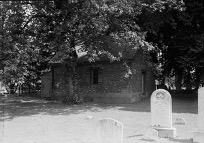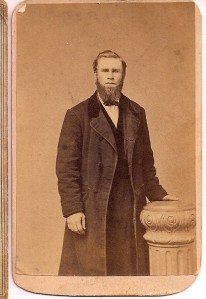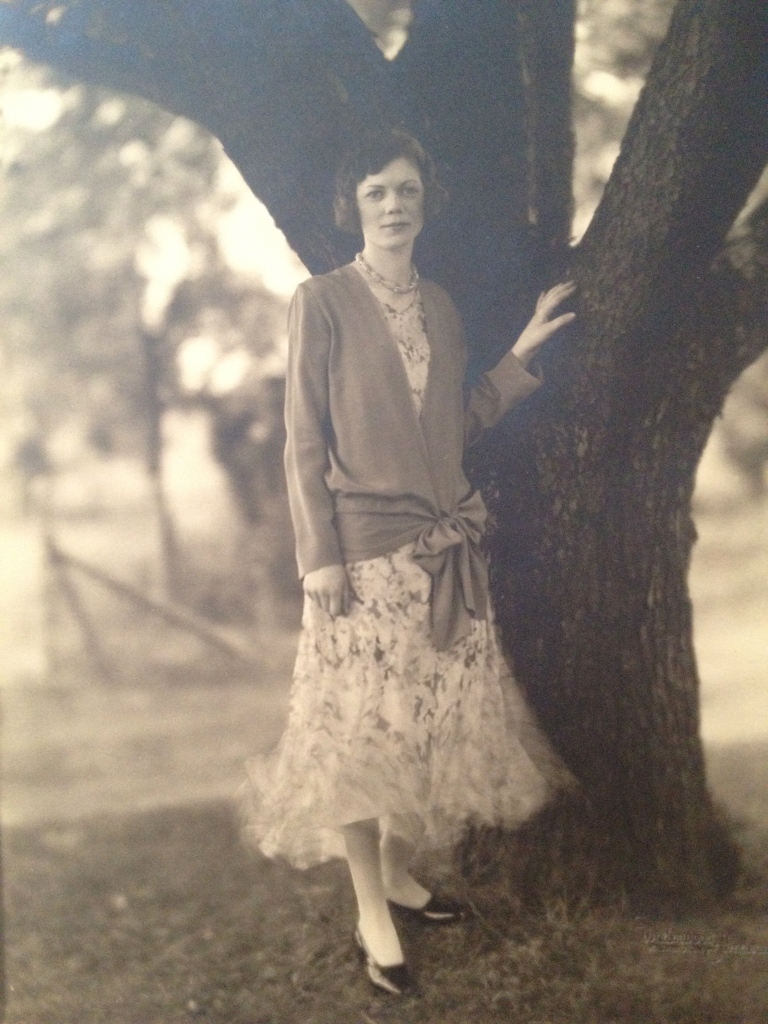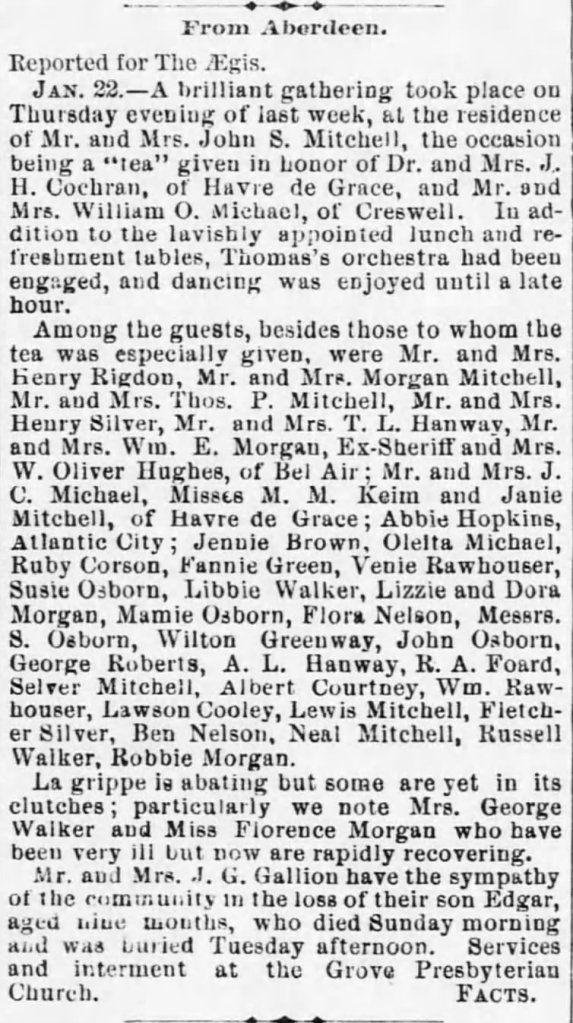a Cannery, a House, and a Legacy of Lost Land
The MITCHELL family are of Scotch descent and can be traced in Harford County since before the Revolutionary War. The area around the Chesapeake Bay that is now Harford County was first discovered by Captain John Smith, of Virginia, who explored and mapped the shores in the summer of 1608.[2] The original county seat of Baltimore was located here along the shores of the Bush River.[3] This part of Maryland, where the Bush River and the Susquehanna River and the Gunpowder River all pour into the Chesapeake Bay was not Harford County until 1773.
Thomas MITCHELL first appears on the tax list of Spesutia Hundred, in what was then Baltimore County, in 1703.[4] Thomas was born around 1682 and arrived in the area at the turn of the 18th century as a servant to an early Dutch immigrant.[5] Sometime before 1713, he married Ann TEAGUE, the daughter of Edward and Susan. On April 15, 1723, Thomas and Ann sold 100 acres of land to a local cooper for 3,500 pounds of tobacco, which they then used to purchase 100 acres on Swan Creek. By the summer of 1725, the couple had purchased another 120 acres of property on Swan Creek.[6] They were prolific in the community – Thomas was a pew holder in the St. George Episcopal Church and tobacco counter for the village.[7]

The land passed from Thomas MITCHELL to his eldest son, Richard, and from Richard down through the eldest sons until in the mid-1800s it belonged to Edmund MITCHELL. The land was then called “Betty’s Choice” or “Bettie’s Choice” and encompassed 160 acres bordered by Boothby Hill to the north and Old Philadelphia Road to the West. Land maps created in 1858 show more of the MITCHELL family in the area east of Boothby Hill as well.[1]

Edmund died in 1892 and the property passed to his son, John Paca MITCHELL. In 1897, Edmund’s nephews John Sappington and E. Lewis MITCHELL – sons of Evan MITCHELL, Edmund’s younger brother – purchased the land from their cousin with the intent of operating the family business from the property.
The MITCHELL family, who had begun acquiring their land by trading in tobacco in the 1700s, expanded their small farming business into commercial corn canning in the late 1800s. John S. and E. Lewis established the John S. Mitchell & Bro. Canning Company in 1881. Similar companies were created in the area by other family members, one by a younger brother, Ralph Morgan, in 1888, and another by an uncle – Frederick O’Neill MITCHELL – in 1882. The F.O. Mitchell & Bro. Canning Company began by canning tomatoes, and then switched to shoe-peg corn. Shoe-peg is a white corn popular in the Southern United States, valued for its sweetness, and characterized by small, narrow kernels tightly and unevenly packed on the cob.

Malcolm Walker MITCHELL was born in Aberdeen in Harford County, Maryland on April 16, 1882. He was the second son of John Sappington and Sarah “Sallie” (TODD) MITCHELL – his brother Howard Holmes MITCHELL was three years older. Not long after their births, the Aberdeen B&O Station was built in 1885. The station was a stop on the new Philadelphia line connecting Washington, DC, to New York City. The newly built railroad cut through the vast fields of corn on course to these bustling cities, and it brought commerce and culture to the center of this community.

In October 1889 a sister was born – Bertha MITCHELL. Family legend says that she was adopted; John S. MITCHELL’s obituary says as much. However, there is no evidence of an official adoption, and the loss of the 1890 census makes it hard to identify her whereabouts just after her birth. Her marriage license in 1916 states her place of birth as Short Lane, Aberdeen – but we do not know if the person reporting this information was Bertha herself or someone else. The 1900 census does say that Sarah MITCHELL had given birth four times, with only two living children. This would imply that Bertha was not a natural child. Regardless, Bertha was raised as a MITCHELL with Howard and Malcolm as older brothers and became “Auntie Ba” to the generations that followed.
Malcolm was a studious boy and a natural leader. When a literary society was organized at Boothby Hill school in 1895, Malcolm was selected President.[8] When his brother and their TODD cousins were reported to have felled 40 ducks hunting in 1901, Mitchell was not among the party. Instead, he could be found among the attendees of end of Lenten dance receptions or co-hosting dinner dances for family and close friends.[9]
The MITCHELL family was active in the community. Aside from being a successful businessman, John MITCHELL was a member of Grove Presbyterian Church, entertained at his home and travelled often. Several events were reported on in the local paper – The Aegis – and guests often included family and friends by the names of MORGAN, MITCHELL, SILVER, MICHAEL, OSBORN, NELSON, STTREET, O’NEILL, CARROLL and RIGDON. Fetes and parties in the early years of Malcolm’s life that were not held at his own home were hosted by other family.

One lawn party in July 1899, a fundraiser for the Fresh Air Society of Baltimore, was held at the home of Charles B. OSBORNE in Aberdeen. Described in The Aegis later, the party had “bunting, flags and Japanese lanterns … artistically arranged about the porches and lawn. In the early part of the evening a literary and musical programme was rendered and a tambourine drill by sixteen little girls was a feature of much applause.” Miss Eva OSBORNE, 15-year-old daughter of the host, is noted as being a “young lady in charge” of the evening.
Also reported in the newspapers, on the same day, a fire broke out in the small rear tenant house of John S. MITCHELL’s property. The MITCHELL family kept servants and took on a boarder to work farm labor – in the 1900 census are listed one servant with her child and one boarder living on the property. The tenant house was destroyed by this fire, but neighbors arrived quickly and assisted in putting out the fire. The big house and other outbuildings in place at the time were spared.[10]
As a young man in Harford County at the turn of the Century, Malcolm would have been exposed to the wealth of the Gilded Age – expansion of the railroad and the boom of the cannery business meant those with means saw this time as a beautiful era – a belle epoch. However, post-Civil War this part of the country was still very much divided – the “Jim Crow” laws being introduced in the Southern part of the United States enforcing racial segregation did not cease to dirty the waters of the Chesapeake, and the people of Harford County were not innocent of the ugliness that pervaded the times.
In March 1900 there were several events near the town of Aberdeen that caused the townspeople to find their way into national news. First, a young white woman was attacked by a recently-released ex-convict, a known rapist, who was also a black man. Just weeks later another assault occurred, this time on an older woman about 54 years of age. She was assaulted at her home near the railway station by a local black man, later identified to be Lewis Harris. Upon hearing her cries for help she was assisted by another black man who chased off the assailant. The assailant was taken to the local jail in Bel Air.[11]
All this would have been excitement enough for 1900 Harford County – but the racial tensions of the day were heightened, it was only thirty years removed from the end of the Civil War, and many of the people in the county were Confederate veterans, or children of veterans. They were segregationists, and many still kept as servants the people who descended from the slaves they had inherited for generations.
Two days after the assailant was brought to the Bel Air jail to await a swift extradition to Baltimore, all was quiet as they kept watch. The Sheriff was anticipating trouble and was hoping to move Harris out of town as soon as possible. However, under cover of darkness, just before midnight, “it was announced that a mob was on its way from Aberdeen … Presently about twenty men appeared, some of whom were masked, and an attach upon the jail began. A fusillade of shots was exchanged between the sheriff and his deputies on the one hand, and the mob on the other.” One deputy was wounded, as was one of the mob from Aberdeen. The name of the person in the mob who was shot in the hand was never ascertained.
Finally, the jail door was forced open and the prisoner removed. As he was dragged from the jail he proclaimed: “If I did it, men, I was drunk and didn’t know what I was about. I have no recollection of it!” The mob dragged him to a neighboring poplar tree and lynched him by his neck. When the tree limb snapped and he fell still breathing, they dragged him up and finished the job. They shot at his body, tied the rope to a gate and left his body swinging until morning.[12]

Two months later, it was reported in the New York Times, that Judge Watters of the Harford County Court beseeched the Grand Jury to vigorously prosecute the men who had taken part in the lynching. “Several persons whom rumor connects with the lynchings were in the courtroom, attentive listeners to the proceedings, and a number of well-known men [were] greatly disturbed over the Judge’s charge.”[13] No charges were ever brought.
There is no way to know for sure if John S., or either Howard or Malcolm, or any of the other MITCHELLS were part of the masked mob. Clearly, no one was ever named publicly besides the victims and assailant – although which was which becomes very muddled with history. What we do know is that they continued on with their normal routines as if none of this ever was happening, in the dark light of the waning crescent moon.
In late 1901 John S. travelled to Canada with his brother Thomas Parker. On their trip visited with the BALDWINS of Ticonderoga, saw the closing of the Pan-American Exposition in Buffalo, and were witness to Annie Edson Taylor surviving the first barrel ride over Niagra Falls.
In the first week of 1904 the recently renovated residence of John S. MITCHELL, called “one of the handsomest in that section of the county,”[14] caught fire and was destroyed. His sons were attending the funeral of Robert P. MITCHELL, the grandfather of Eva OSBORNE and a cousin, at the Grove Presbyterian Church, while their father reposed at home recovering from an illness. Howard and Malcolm received word of the fire and rushed home in time to assist in recovering some of the furniture. However, due to a lack of sufficient water supply the home could not be saved. Half of the furniture, a large quantity of silverware and money was lost. “A large bedroom on the east of the house, where a number of valuable pieces of silver many of which were wedding presents belonging to Mrs. Howard H. MITCHELL, could not be entered at all. In this room, Mrs. John S. MITCHELL had also a purse containing sixty dollars and a suite of handsome furniture. A number of valuable pictures and a great deal of wearing apparel were consumed.”[15] The note about the loss of valuable pictures may be the saddest part – as photography was new at this time, that this fact is mentioned is evidence that the MITCHELLs had many photos, likely of many generations, that were lost to this fire over a hundred years ago.
In 1905, E. Lewis MITCHELL sold his half of “Betty’s Choice” to his brother, John. John and his sons set about rebuilding a new residence.
In early January 1905, the Mitchell family, along with many other Harford County residents, attended the 25-anniversary party of Charles B. and Jerusha OSBORNE. A month later, in early February, Malcolm threw a sledding party on a Saturday evening for the younger set. First on the guest list was Eva OSBORNE and her closest friends, Virginia and Lilly Courtney. Other MITCHELLs and OSBORNEs were also in attendance. By November of 1905 it was announced that Malcolm, then 23, and Eva, then 19, were to be married.
On November 15, 1905, Mitchell and Eva were married in the Presbyterian Church in Havre de Grace. The bridal party travelled to the church in automobiles. The bride wore pale regina silk with Irish point lace; on her veil was pinned a spray of orange blossoms and she carried a bouquet of bridal roses. Her bridesmaids, Virginia COURTNEY and Elsie BILLINGSLEA, wore crepe-de-chine and Paris muslin trimmed with lace and carried bouquets of chrysanthemums.[16] The church was festooned with arches of evergreen and a floral bell, which included an electric light, hung above the altar. After the ceremony, a reception was held at the home of the bride’s parents, Charles B. and Jerusha G. (MITCHELL) OSBORNE, on Bel Air Avenue in Aberdeen.[17] The couple left that evening for their honeymoon: a Southern tour.
On the same night as their wedding, the new barn and a barrack on the Short Lane property burned to the ground. Lost were forty tons of hay, a carload of oats, beans, and corn, and two calves. Mitchell and Eva were already off on their honeymoon when the fire erupted, but several wedding guests were able to attend to the fire from the reception. The wind was moving away from the new house, so luckily it was not destroyed.[18]


The Short Lane house was built in 1905 by John S. and Malcolm MITCHELL and completed prior to the occasion of his marriage to Eva. Once they returned from their honeymoon, they immediately took up residence there. In January 1906, it was reported that Malcolm was “having the old dwelling-house removed from his property near Boothby Hill, where is now occupying a handsome new residence.”[19]

For details on the Short Lane house – the design elements and style, materials used in the building and the overall layout of the home – please visit The Short Lane House family story.
The house was home to the new couple, Malcolm and Eva MITCHELL, as well as his parents and his uncle Evan Lewis MITCHELL, in 1906. However, in May of that year, Malcolm’s mother Sarah died of a brain clot. John S. never recovered from his wife’s death. He passed away the following January. Malcolm and Eva also grieved a child in 1906 – they gave birth to a daughter whose birth and death are listed as December 19, 1906.
After John S. MITCHELL’s death in 1907 the land at Short Lane passed to his sons. Howard sold his half interest to Malcolm. Malcolm stayed in the home and Eva gave birth to daughter Jerusha Gertrude MITCHELL on October 3, 1908. In 1911 the couple again lost a child – this time an infant son born and died March 17, 1911. On December 29, 1913, they welcomed a son they named Evan Malcolm.

At the age of 28 Malcolm MITCHELL was a business owner of a canning factory and homeowner of a handsome new house. Malcolm continued to operate the John S. MITCHELL & Bro. Canning Company throughout the next two decades. The company is listed as operating on Short Lane, focusing on canning corn, in the 1919 “Directory of Canners” and the 1927 “Tri-State Packers Association Directory.”[23]
Uncle Evan Lewis MITCHELL continued to live in the home as the family expanded. The 1920 census shows the Short Lane house occupied by Malcolm (37) and Eva (36), Jerusha (11), Evan (6), and Evan L. (75), along with two male servants in their 20s (one white, one black), a female servant in her late 70s (a black woman listed with the family back several censuses), and a young black female cook.[24] In the 1930 census, only the one black male servant remains with the family and by 1940 it is just Malcolm and Eva, Evan M. and his wife.


With the outbreak of World War I in 1917, the government began looking to acquire rural land where they could safely test munitions. Colonel Ruggles of the United States Army was charged with finding somewhere near enough to industrial centers of the eastern seaboard, but away from heavily populated areas. He chose the agricultural area along the Chesapeake which included Aberdeen. An Act of Congress and two Presidential Proclamations allocated over 35,000 acres of land (and even more of tidal land and swamp), which encompassed 650 acres of MITCHELL farmland, for the new Aberdeen Proving Grounds (APG).[25] Thousands of people had to relocate, along with their livestock, from the land.
The impact that this had on the local canning business cannot be overstated. Many of the individual canneries that had succeeded in the Bush River neck closed when they were forced to abandon their property. Short Lane continued in operations, but much of the farmland they relied upon was stripped and so the Short Lane cannery closed by the 1930s and operations were consolidated to the F.O. Mitchell and Bro. Canning Company. F.O. Mitchell & Bro Canning Company was the most successful and enduring of the MITCHELL canneries; the MITCHELL cousins worked together at the Perryman location and continued operations here until 1985.

Meanwhile, the family remained in the Short Lane house. Jerusha married in February 1933 to a local farmer’s son, Charles Taylor OLIVER. The marriage took place at Grove Presbyterian Church in Aberdeen.




L-R (Franklin L. OLIVER, William G. OLIVER, Charles T. OLIVER, unnamed pastor, Jerusha (MITCHELL) OLIVER, Malcolm MITCHELL, Virginia COURTNEY, Evan M. MITCHELL
During the second World War, the APG again expanded. This time, the government took another 7,000 acres. “Betty’s Choice,” the Short Lane house (referred to as the “Malcolm Mitchell” house in Maryland Historical records and APG documents), and at least two other parcels of land belonging to Malcolm were seized by eminent domain in 1941 and incorporated the property into the Aberdeen Proving Grounds.[26]

After the family removed from the home, the APG converted the property to army housing for officers. It remained in use as housing through 1959 for captains and other high-ranking officials. It the 1990s it became office space and accommodated a Cultural and Natural Resources Visitors and Learning Center. APG ceased use of the property in 2008. It was abandoned on the outer edge of the Ruggles Golf Course on the APG property until 2019 when it was set for demolition. It has since been razed by the government.
After leaving the Short Lane home, Malcolm and Eva lived in a house in downtown Aberdeen. But Malcolm died very suddenly in 1947. Eva lived another twenty years and died in 1966.
Jerusha and her new family lived at home with Malcolm and Eva for the births of their first children, Carolyn (b. 1935) and Gertrude (b. 1936), and possibly for the births of their twins, Charles and Elsie (b. 1939). But by the U.S. Census of 1940, they had moved moved to the Colonel Baldwin house at 201 East Bel Air Avenue, just down the road from Grove Presbyterian Church, and a stone’s throw from the entrance to the new Aberdeen Proving Ground.

This is another home listed on the historic registry.
This home is where many family events and gatherings took place, and daily life ebbed and flowed happily for many years. And the house has a history of its own.
But that is another story, for another time.
[1] Jennings and Herrick Map of Harford County 1858 District 2
[2] https://www.chesapeakebay.net/discover/history/captain-john-smith
[3] https://en.wikipedia.org/wiki/Baltimore
[4] Virginia Horner Hines, Our Horner Ancestors (Chicago Adams Press, 1974) p.222
[5] Henry C. Peden, Jr., ed., Abstracts of the Baltimore County Land Commissions 1727-1762 (Westminster, MD; Family Line Publications, 1998), p. 451
[6] John Davis, Baltimore County, Maryland Deed Records 1659-1737 (Bowie, MD; Heritage Books, Inc., 1996) 1:292; p. 317
[7] Bill and Martha Reamy, St. George’s Parish Registers (Harford County, Maryland) 1689-1793 (Westminster, MD: Heritage Books, 2010), p. 103

The Aegis newspaper January 24, 1890
[8] The Aegis, Bel Air, MD, 1 Nov 1895, page 3.
[9] The Aegis, Bel Air, MD, 13 Nov 1901 and 21/28 Feb 1902, page 3.
[10] The Aegis, Bel Air, MD, 21 Jul 1899, page 3.
[11] “Assaulted by A Negro: A Belair, Md., Woman’s Desperate Struggle With an Assailant,” The Times, Washington , March 26, 1900.
[12] “Lewis Harris Lynched,” Evening Star, March 27, 1900.
[13] “To Investigate A Lynching,” New York Times, May 15, 1900 (emphasis added)
[14] The Aegis, Bel Air, MD, 8 Jan 1904, page 3.
[15] Ibid.
[16] The Aegis, Bel Air, MD, 24 Nov 1905, page 3.

The Aegis newspaper November 24, 1905
[17] Ibid.
[18] Ibid.
[19] The Aegis, Bel Air, MD, 26 Jan 1906, page 3.
[20] Harford County Deed Records
[21] Heating, Ventilating and Sanitary Plumbing, Volume 10, pg. 16; Heating & Ventilation Magazine, New York, March 1900
[22] All building details courtesy of Maryland Historical Trust, Maryland Inventory of Historic Properties, No. HA-2199, Malcolm MITCHELL House (Building 5650, Aberdeen Proving Ground) Architectural Survey File, https://apps.mht.maryland.gov/medusa/PDF/Harford/HA-2199.pdf. Home accents such as furniture and décor descriptions taken from family photos.
[23] Kee, Ed. “Saving Our Harvest: The Story of the Mid-Atlantic Region’s Canning and Freezing Industry.” CTI Publications, Inc., Baltimore, MD. 2006:322.
[24] 1920; Census Place: Halls Cross Roads, Harford, Maryland; Roll: T625_675; Page: 9A; Enumeration District: 89
[25] https://home.army.mil/apg/about/history; https://apps.mht.maryland.gov/medusa/PDF/Harford/HA-2199.pdf
[26] Maryland Historical Trust, Maryland Inventory of Historic Properties, No. HA-2199, Malcolm MITCHELL House (Building 5650, Aberdeen Proving Ground) Architectural Survey File, https://apps.mht.maryland.gov/medusa/PDF/Harford/HA-2199.pdf

